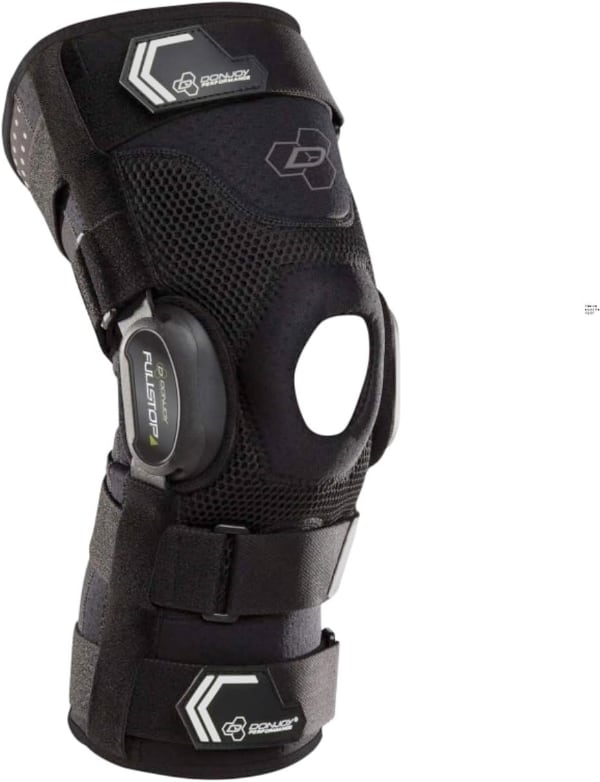In order to better understand how anterior cruciate ligament braces work it is important to understand basic knee anatomy and the function of the anterior cruciate ligament (ACL). Please review the sections on knee anatomy and on ACL injuries before reading this section.

The ACL is one of the main stabilizing ligaments of the knee. The ACL helps stabilize the knee by preventing excessive forward movement or rotation of the shin bone (tibia) on the thigh bone (femur). If the ACL is significantly damaged the knee can feel “unstable” or it may “give out”. Depending on the type and severity of the injury, other structures in the knee may be damaged in addition to the ACL. There may be injuries to the “shock absorbing” cartilage (menisci), the collateral ligaments (MCL or LCL), the posterior cruciate ligament (PCL) or to the bones of the knee. The degree of injury to the ACL may vary. In some cases the ACL may only be partially torn or in more serious cases the ACL may be completely torn. Unfortunately, the ACL does not have the ability to completely heal once it is injured.
After an ACL injury the long term goal is to return the individual back to their previous level of activity. Achieving this goal will depend on the function and stability of the knee. A general knee rehabilitation program which includes strengthening exercises, flexibility exercises, aerobic conditioning, technique refinement and proprioceptive (biofeedback) retraining is the most important factor in improving knee function and stability. Stability may be improved by an ACL knee brace and/or surgery to reconstruct the ACL.
What is an ACL Brace?
ACL braces have a light-weight frame and hinges at the knee joint. Straps help secure the brace to the knee. This type of construction allows the knee to bend and straighten while providing rotational support to the knee. ACL braces also provide support to the inner (medial) and outer (lateral) aspects of the knee. An injured knee can be fit with an “off the shelf” brace or a custom fit brace. The type of brace depends on the size and shape of the individuals’ leg.
ACL braces are designed to reduce knee instability following an injury to the ACL. In general, people with ACL injuries report an improved sense of stability when wearing an ACL brace. ACL braces are usually recommended for twisting, pivoting, cutting or jumping activities. In addition to providing increased stability to the knee, ACL braces may also decrease the risk of injuring other parts of the knee. ACL braces have also been recommended after ACL reconstructive surgery to reduce the stress on the ACL graft.
What are some drawbacks of ACL Braces?
ACL braces have some drawbacks. Some people report that they are heavy, hot and cumbersome. ACL braces can also be expensive. Furthermore, ACL braces do not always work. Sometimes they do not improve the stability of an ACL injured knee especially when the knee is very unstable or there are other significant ligament injuries to the knee. ACL braces do not return normal stability to the knee, so the knee may still feel unstable under high forces. However, when ACL braces are fitted properly and when used in conjunction with a general knee rehabilitation program ACL braces can serve an important role in the treatment of ACL injuries. Doctors and physiotherapists who treat ACL injuries can advise whether a brace would be helpful and how to get the brace.
How do I know if an ACL brace would be helpful for me?
Doctors and physiotherapists who treat ACL injuries can advise whether a brace would be helpful and where and how to get the correct brace. ACL braces should be considered as part of the treatment and rehabilitation for ACL injuries. Not only can they control some of the instability in a knee with an injured ACL but they can also be useful to protect the ACL graft following ACL reconstructive surgery.
Please visit the links section for additional information on ACL braces. Links have been provided to other websites as well as online medical journals. Other knee injury topics can also be accessed.
A recommended ACL Knee Brace:

DonJoy Performance BIONIC FULLSTOP ACL Knee Brace
- Hinge technology and a four-point leverage system trains users to stay out of the “at-risk” position through a dampening cycle of the hinge
- Compression and thermal heat regulation keeps you from overheating; Anti-migration technology prevents sleeve movement
- Adjustable straps enable greater customizability for a more secure, personal fit; Reflectivity for enhanced visibility in low-light conditions
- Designed to treat and protect ACL and meniscus injuries, joint instabilities, moderate ligament and tendon sprains, hyperextension, and patella support
